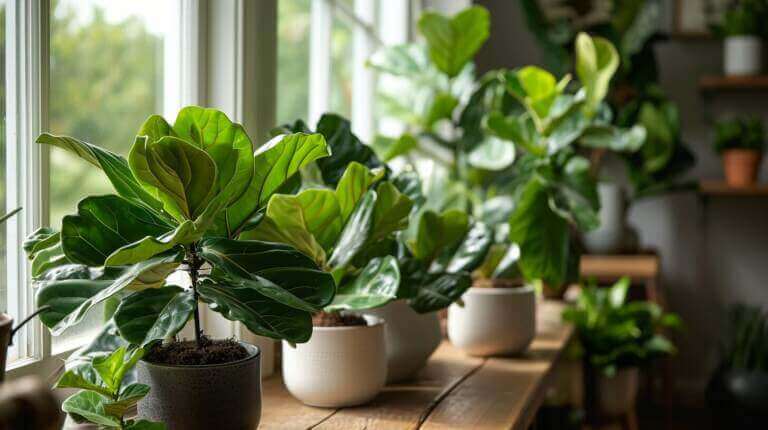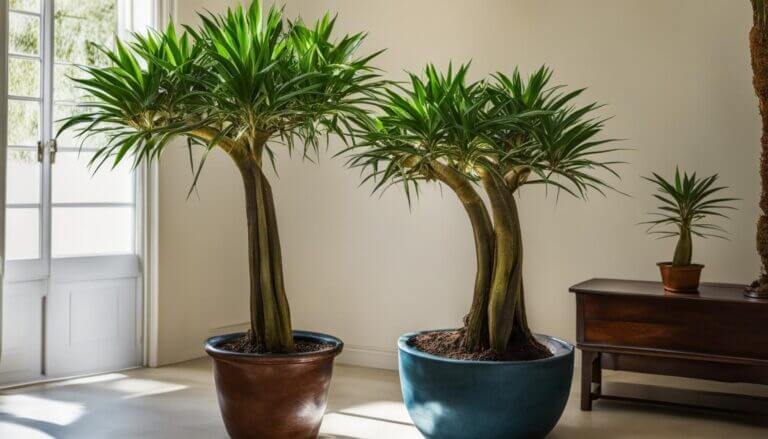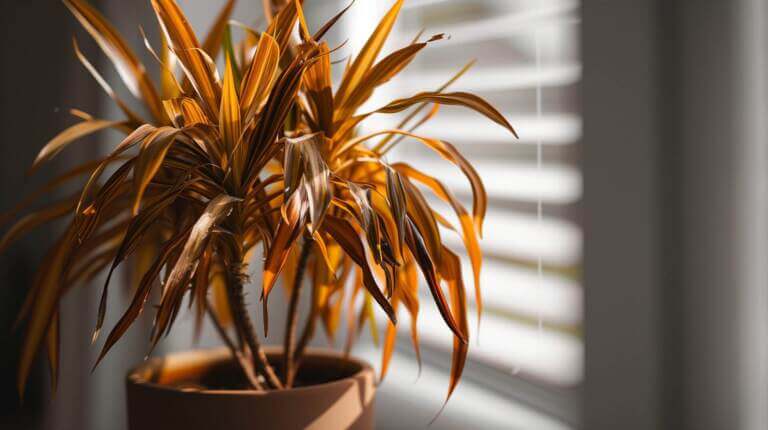Key Takeaways:
- Rubber plants, also known as Ficus elastica, can be propagated from stem cuttings.
- The best time to take cuttings is during the plant’s active growing season in spring and summer.
- Cuttings should be 4-6 inches long and have 2-3 leaves trimmed by half. Make a straight cut below a leaf node.
- Dip the cutting in rooting hormone powder to encourage root growth. Plant in moist potting mix.
- Keep the cutting warm and humid, out of direct sunlight. Roots and new growth will emerge in 4-8 weeks.
- Mature rubber plants can also be propagated by air layering. Make a cut halfway through a stem and wrap sphagnum moss around the cut.
- Keep moss moist until roots form after a few weeks. Then sever the stem below the root ball and pot up the new plant.
- Water new rubber plants sparingly until established. Gradually acclimate them to normal light levels and reduce humidity.
Preparing To Propagate a Rubber Tree Plant(Ficus Elastica)
Selecting a healthy stem for cutting
Hey plant lovers! If you’re eager to expand your rubber indoor plant collection, one great way to do it is through propagation. Propagation allows you to create new plants from existing ones, and it’s a fun and rewarding process. Let’s get started!
The first step is to select a healthy stem for cutting. Look for a stem that is about 6-8 inches long and has at least 2-3 sets of leaves. Make sure the stem is free from any diseases or pests. It’s also important to choose a stem that is not too woody or too soft. A medium-sized stem with mature leaves is the ideal choice.
Tools and materials needed for propagation
To successfully propagate your rubber plant, you’ll need a few essential tools and materials. Here’s a list of what you’ll need:
- Pruning shears or a sharp knife: These will be used to cut the stem from the parent plant. Make sure your tools are clean and sharp to avoid damaging the stem.
- Rooting hormone: This is an optional but helpful tool. It can increase the chances of successful rooting by providing a boost of nutrients and stimulating root growth. You can find rooting hormone at your local garden center or online. Gently moisten and dip one end of the cutting into the rooting hormone, tap to remove excess.
- Pot and soil: You’ll need a small pot with drainage holes and well-draining soil. A mixture of potting soil and perlite or sand works well for rubber plants.
- Watering can or spray bottle: You’ll need a watering can or a spray bottle to water your newly propagated rubber plant.
- Plastic bag or humidity dome: A plastic bag or a humidity dome will help create a humid environment for your cutting, which can promote root development.
Propagate Rubber Plant From Cuttings: Step-by-Step Guide
Being able to propagate your own rubber plant can be an exciting and rewarding experience. Here is a simple step-by-step guide to help you successfully propagate a rubber plant cutting.
Step 1: Making a clean cut on the stem
To start the propagation process, choose a healthy rubber plant stem that is about 6-8 inches long. Using a clean, sharp knife or pruning shears, make a clean cut just below a node, which is the point where leaves and branches grow. Make sure the cut is straight to promote better rooting.
Step 2: Applying rooting hormone
Applying rooting hormone to the cut end of the rubber plant stem can help stimulate root growth. Dip the cut end into a small container of rooting hormone powder, making sure to cover the entire cut surface. Shake off any excess powder before proceeding to the next step.
Step 3: Planting the cutting in a suitable pot
Prepare a pot filled with a well-draining potting mix, such as a mixture of equal parts peat moss, perlite, and vermiculite. Create a small hole in the soil and gently place the cut end of the rubber plant stem into the hole, ensuring that at least half of the stem is immersed in the soil. Firmly press the soil around the stem to provide stability.
Step 4: Providing the ideal environment for rooting
To encourage successful rooting, it is important to provide the cutting with the ideal environment. Place the potted cutting in a warm and bright location, but away from direct sunlight. Keep the soil consistently moist but not waterlogged. You can cover the cutting and pot with a clear plastic bag or place it in a propagation tray to create a humid environment that aids in root development.
Remember to regularly check the soil moisture and mist the cutting if necessary to maintain humidity. Within a few weeks to a couple of months, you should start to notice new growth and roots forming on the rubber plant cutting.
Propagation provides a unique opportunity to expand your rubber plant collection or share it with friends and family. With a little patience and care, you can successfully propagate a rubber plant and enjoy the beauty of these lush green plants in your home.
Alternative Propagation Methods Using Air Layers
Layering as an alternative method
When it comes to propagating a rubber plant, there are alternative methods aside from using cuttings. One such method is layering. Layering is the process of rooting a branch while it is still attached to the parent plant. Here’s how you can do it step-by-step:
- Identify a healthy and flexible stem that you wish to propagate.
- Create a small wound on the stem by gently scraping off a small portion of the bark. This will encourage root growth.
- Apply a rooting hormone to the wounded area. This will help stimulate root development.
- Take a small handful of moist sphagnum moss or a soilless potting mix and wrap it around the wounded area of the stem.
- Wrap plastic wrap or a plastic bag around the moss to hold it in place and create a moist environment.
- After a few weeks, check for root development by gently tugging on the stem. If there is resistance, roots have formed.
- Cut the stem below the rooted area and plant it in a pot filled with well-draining soil.
Caring for the Newly Propagated Plant Houseplant
As a plant enthusiast, I have always enjoyed propagating new plants and watching them thrive. One plant that is particularly easy to propagate is the rubber plant. If you are interested in expanding your rubber plant collection, here is a step-by-step guide on how to propagate a rubber plant successfully.
Watering and soil requirements
Once you have taken a cutting from your rubber plant, it’s important to treat it with care to ensure successful growth. When it comes to watering, make sure to keep the soil consistently moist but not soggy. Overwatering can lead to root rot and other problems. Choose a well-draining potting mix to provide the right conditions for your new plant to flourish.
Avoiding common mistakes in caring for propagated rubber plants
To give your propagated rubber plant the best chance at thriving, there are a few common mistakes you should avoid:
- Overwatering: As mentioned earlier, overwatering can be detrimental to your new plant’s health. It’s essential to strike a balance and avoid letting the soil become waterlogged.
- Insufficient light: Rubber plants thrive in bright, indirect light. Place your newly propagated plant in a location where it will receive ample light to promote healthy growth. Avoid placing it in direct sunlight, as this can scorch the leaves.
- Neglecting humidity: Rubber plants prefer a humid environment. To mimic their native tropical habitat, you can use a humidifier or place your plant on a tray filled with water and pebbles.
- Forgetting to prune: Regular pruning is essential for the overall health and shape of your rubber plant. Trim any dead or yellowing leaves to maintain its appearance and encourage new growth.
FAQ
How do I propagate a rubber plant?
Propagating a rubber plant can be done through several methods such as taking cuttings or using air layering.
What is the process of propagating a rubber tree cuttings?
To propagate a rubber plant from cuttings, follow these steps:
1. Select a healthy stem from the mother plant, making sure it is at least 6 inches long.
2. Use clean, sharp shears to cut just below a node (the small bump or swelling on the stem).
3. Remove any leaves from the lower half of the cutting.
4. Dip the cut end of the stem in rooting hormone powder to encourage root growth.
5. Place the cutting in a small container filled with well-draining potting soil.
6. Keep the soil slightly moist and place the container in a bright, indirect light location.
7. After a few weeks, new roots should start to form. Once the roots are established, you can transplant the new plant into a larger pot.
How do I propagate a rubber plant by air layering?
To propagate a rubber plant by air layering, follow these steps:
1. Select a healthy, mature stem on the rubber plant.
2. Make a small diagonal cut on the stem, about 1/3 of the way through.
3. Apply rooting hormone to the cut area.
4. Wrap moist sphagnum moss around the cut area.
5. Cover the moss with plastic wrap and secure it with a rubber band.
6. Leave the plastic wrap in place for several weeks, ensuring that the moss remains moist.
7. Once roots have formed, cut off the rooted section of the stem below the moss and plant it in a pot with well-draining soil.
Can I propagate a rubber plant from a leaf cutting?
No, rubber plants cannot be propagated from leaf cuttings. They require stem cuttings for successful propagation.







